Milan printable map of top tourist attractions & city travel guide
Milan city centre free travel guide - Top 10 must-see sights & best destinations - Milan top tourist attractions map
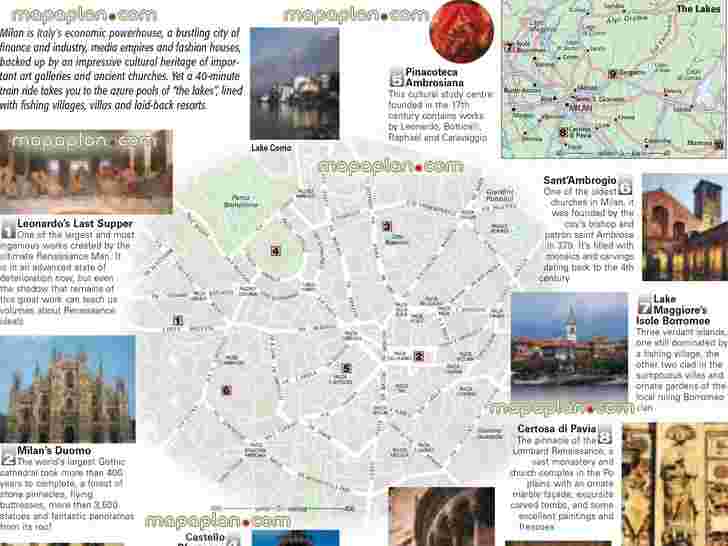
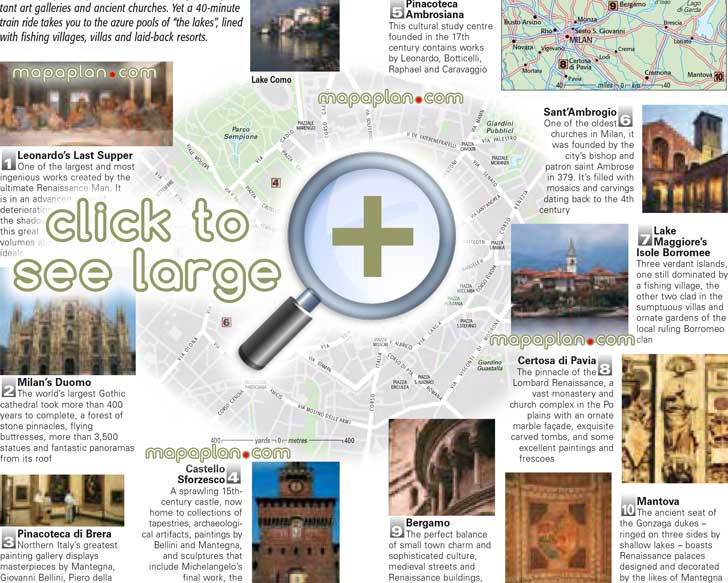
Maps of best attractions in Milan, Italy
Milan maps will guide you to the best destinations in the city. Think of Milan as a series of concentric circles radiating from the Piazza del Duomo at the center. Within the inner circle, once enclosed by the city walls, are the top tourist attractions including churches, museums, and shops that will consume your visiting hours. Milan is Italy’s city of the future, a fast-paced metropolis where creativity is big business, looking good is compulsory and after-work drinks are an art form. It’s also a city with ancient roots and extraordinary treasures that you'll get to experience without the usual queues of tourists. Then, at the weekend, join the urban exodus to the elegant towns and tiered gardens of the Italian lakes. Milan's top sights and key landmarks to visit are plotted on our detailed city plans. Public transportation points are also marked, and indicated by the symbols listed in the maps key. Armed with these maps, you should be able to find the accurate location of must-see places. Mapping out a trip to explore Milan can be far from the usual. This page includes a range of maps and plans which will help you make the most of your visit to Milan. If you are either a first-time tourist looking for the top 10 must-do sights or if you are returning to Milan to discover something new - all you need to ensure an enjoyable trip is some advance planning. For some help in narrowing down the options, we present you with a range of high resolution maps which will help you find the detailed locations of the must-see sights - just click on a selected map to access a large version that can be downloaded and printed, or saved onto your mobile device. When in Milan, you can also get free pocket-size maps of the city from the tourist information centres.
Central Milan, Italy top tourist attractions free printable guide map download - Visitor's 3d virtual interactive information plan with main points of interest, museums, landmarks including old town's Duomo - Milan top tourist attractions map
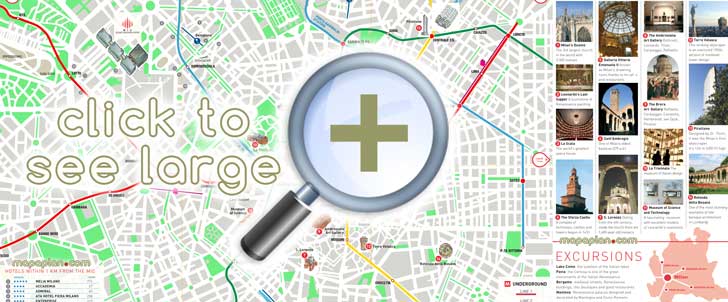
You can view, download or print a full, high resolution (detailed, large) version of this image by clicking on the plan itself
Milan inner city centre top attractions detailed downloadable map of best historical buildings - What to see, where to go, directions to interesting things to do guide in English - Milan top tourist attractions map
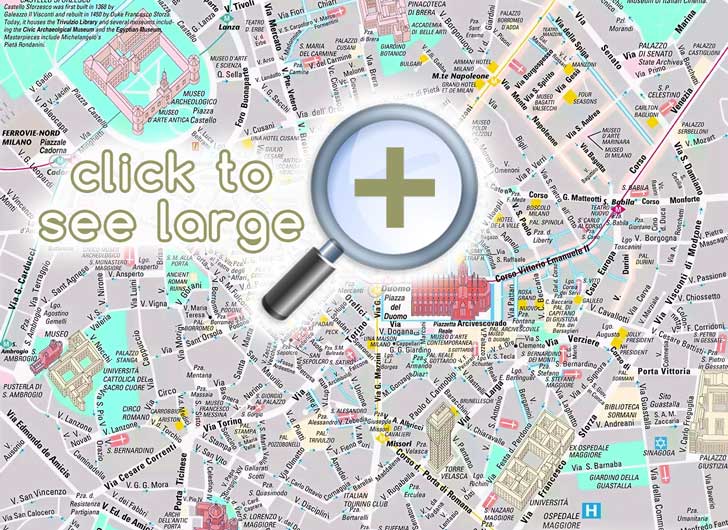
You can view, download or print a full, high resolution (detailed, large) version of this image by clicking on the plan itself
Milan interactive virtual guide map showing must-see places - Travel layout English guide free download - Offline map showing attractions & places to visit - Inner city plan showing places of interest along with street names & must-see destinations - Milan top tourist attractions map
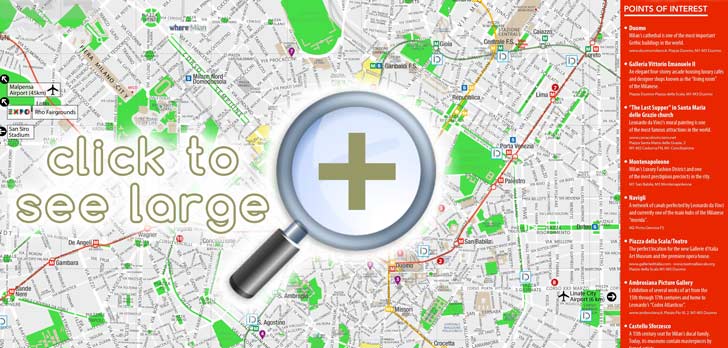
You can view, download or print a full, high resolution (detailed, large) version of this image by clicking on the plan itself
Milan metro underground network printable map showing ATM M1, M2, M3, M4 lines, suburban light rail network zones, airport - Updated subway train public transport diagram - Milan top tourist attractions map
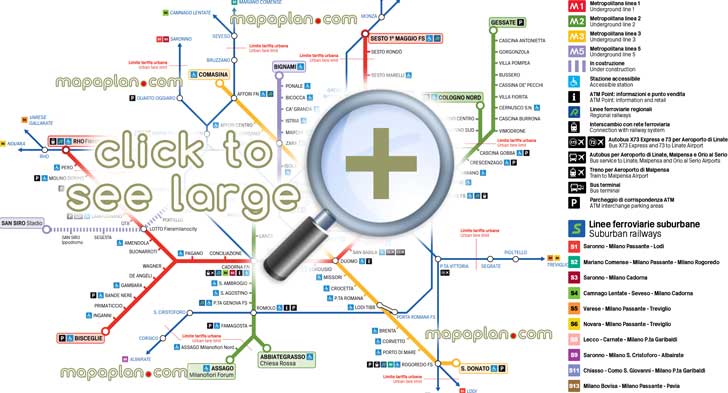
You can view, download or print a full, high resolution (detailed, large) version of this image by clicking on the plan itself
Milan city centre new map to download showing metro underground stations, tram streetcar & trolley lines, bus stops & terminal, suburban railways - Tourist information guide map of attractions, public transportation network - Milan top tourist attractions map
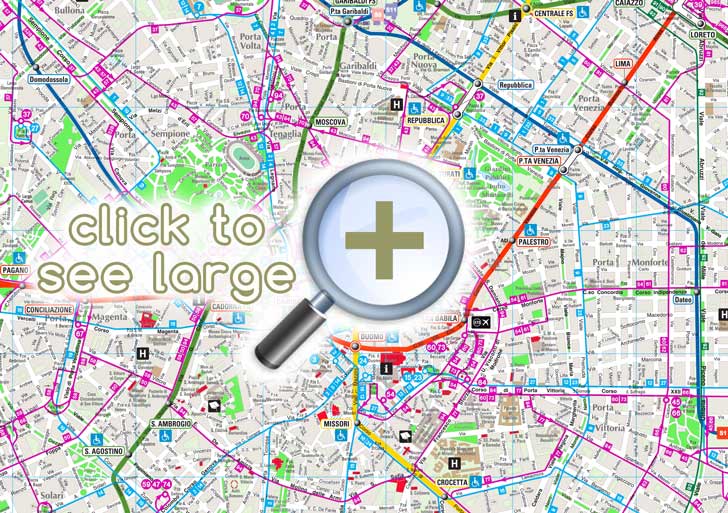
You can view, download or print a full, high resolution (detailed, large) version of this image by clicking on the plan itself
Hop-on hop-off bus map of Milan City sightseeing tour for tourists - Double decker open top couch visitors' plan showing tour routes - Bird's eye graphical overview of the city trip highlights - Milan top tourist attractions map
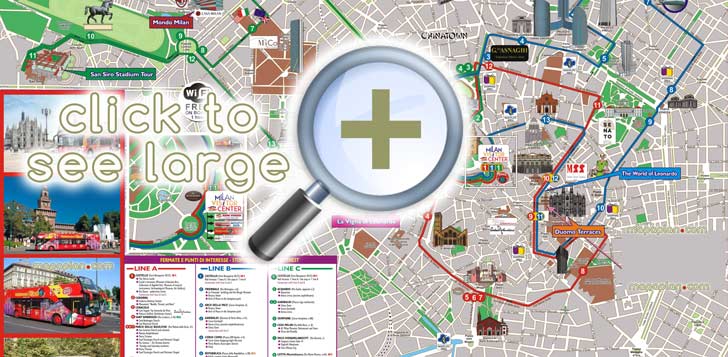
You can view, download or print a full, high resolution (detailed, large) version of this image by clicking on the plan itself
Historic centre printable map with the list of points of interest in old town district area neighbourhood - High quality road guide & street names large scale plan showing Duomo, Pinacoteca Ambrosiana, Galleria Vittorio Emanuele II shopping gallery - Milan top tourist attractions map
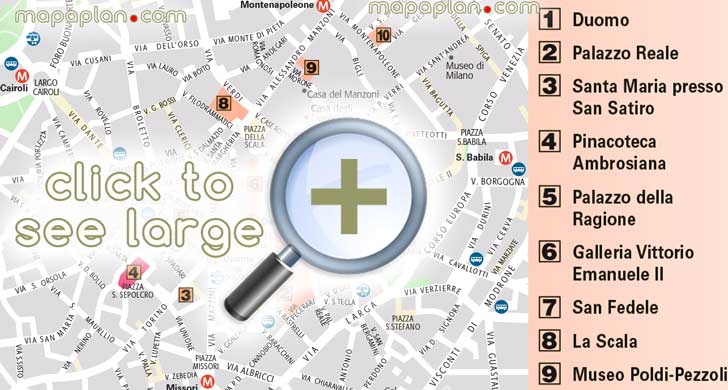
You can view, download or print a full, high resolution (detailed, large) version of this image by clicking on the plan itself
Northern Milan detailed free map - Simple & easy to navigate diagram of Milan inner city centre showing holiday top points of interest, central walkable sites, city-break historical places to visit including Santa Maria delle Grazie Church, Sforzesco Castle - Milan top tourist attractions map
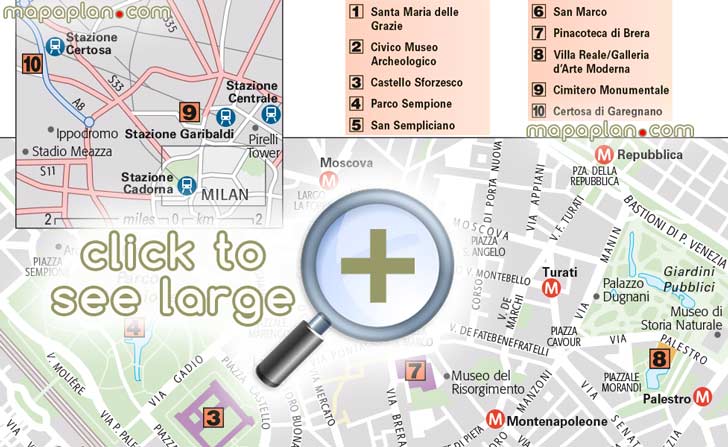
You can view, download or print a full, high resolution (detailed, large) version of this image by clicking on the plan itself
Southern Milan jpg map & walking tour guide itinerary planner showing layout of best things to do - 1-day trip travel map with locations to visit, must-see tourist attractions, famous destinations, must-do spots & landmark destinations including Leonardo Da Vinci Museum - Milan top tourist attractions map
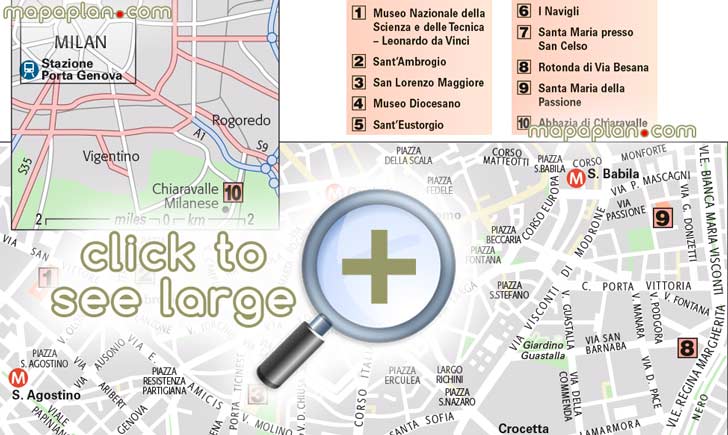
You can view, download or print a full, high resolution (detailed, large) version of this image by clicking on the plan itself
Milano Centro Storico mappa - City Centre interactive walking trip downloadable itinerary planner to print & guide map showing best destinations to visit - Central district area outline layout map of best locations - Milan top tourist attractions map

You can view, download or print a full, high resolution (detailed, large) version of this image by clicking on the plan itself
Brera District printable walking tour guide itinerary planner map with favourite attractions & points of interest to visit by tourists showing churches, San Marco Market, Cimitero Monumentale - Milan top tourist attractions map
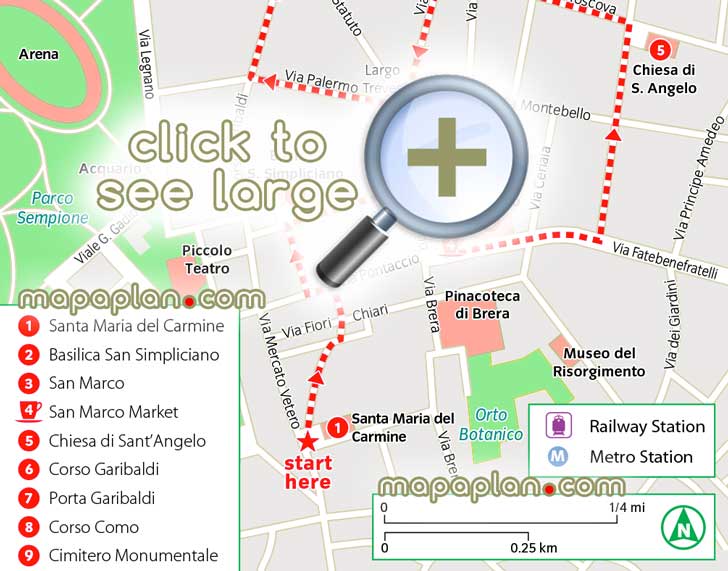
You can view, download or print a full, high resolution (detailed, large) version of this image by clicking on the plan itself
Central Milan, Italy city center great historic spots & best must-see sights printable map showing metro stations, location of official tourist information center, Piazza Duomo - Milan top tourist attractions map
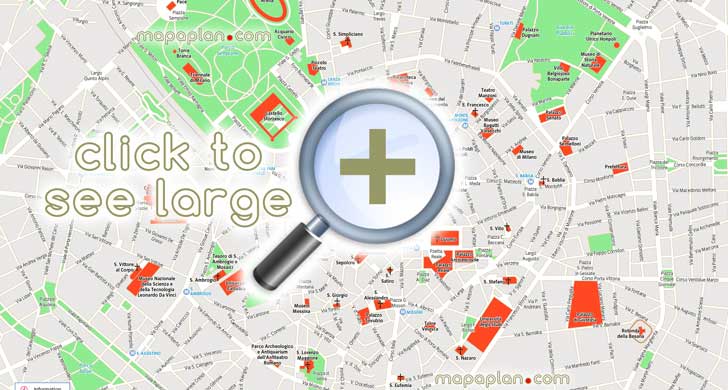
You can view, download or print a full, high resolution (detailed, large) version of this image by clicking on the plan itself
Download the free virtual explorer plan showing interesting sites & hot spots worth visiting - Historic churches map with Duomo, Basilica di San Lorenzo Maggiore, Santa Maria delle Grazie - Milan top tourist attractions map
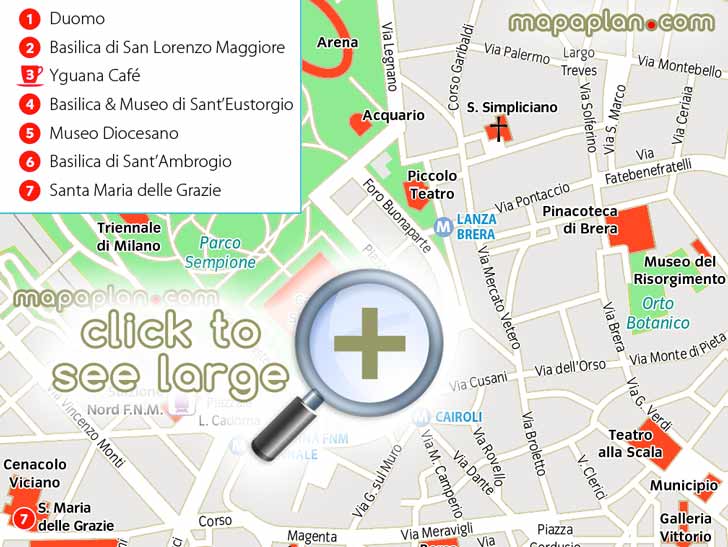
You can view, download or print a full, high resolution (detailed, large) version of this image by clicking on the plan itself
Milan museum & art galleries free map download - Itinerary planner with navigation to best sights, travel sites, landmarks including Pinacoteca di Brera, museums, churches, art galleries - Milan top tourist attractions map
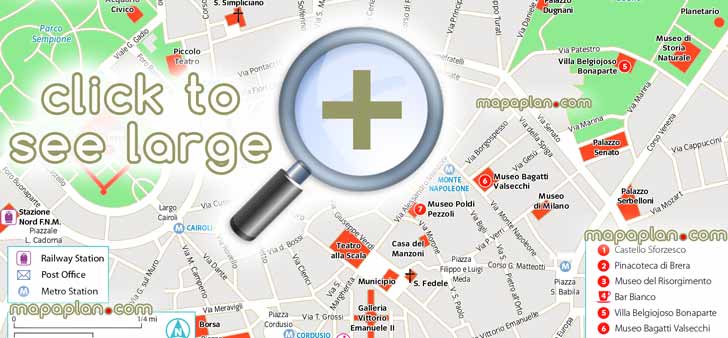
You can view, download or print a full, high resolution (detailed, large) version of this image by clicking on the plan itself
Milan virtual interactive 3d aerial graphical satellite view map showing orientation & navigation to top tourist attractions to visit - Milan top tourist attractions map
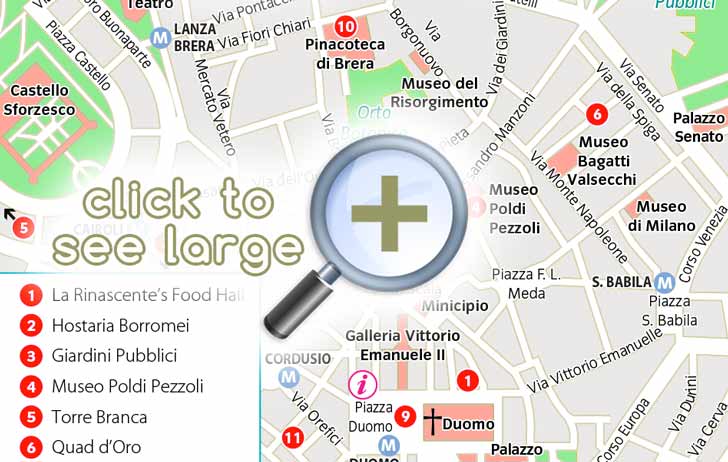
You can view, download or print a full, high resolution (detailed, large) version of this image by clicking on the plan itself
Visitor's guide map showing metro stations and best of Milan top points of interest - Free to download street & road names detailed hd map - Milan top tourist attractions map
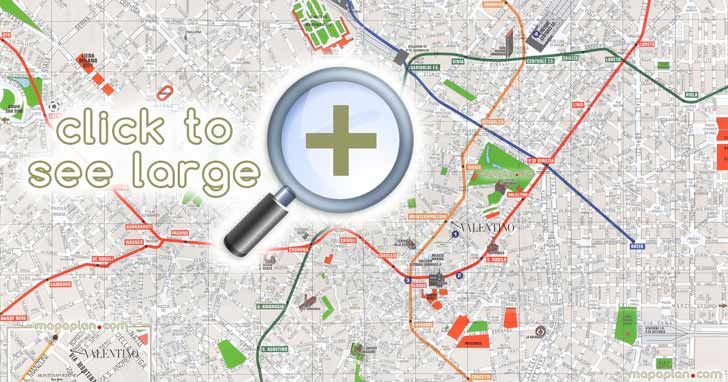
You can view, download or print a full, high resolution (detailed, large) version of this image by clicking on the plan itself
Milan 3-day itinerary planner with the list of top things to visit & see - Central Milan main neighbourhoods free download plan - Milan top tourist attractions map

You can view, download or print a full, high resolution (detailed, large) version of this image by clicking on the plan itself
Milan downtown shopping destinations & fashion district map showing list of most popular shops with metro stations, markets, famous department stores including the iconic Galleria Vittorio Emanuele II - Milan top tourist attractions map
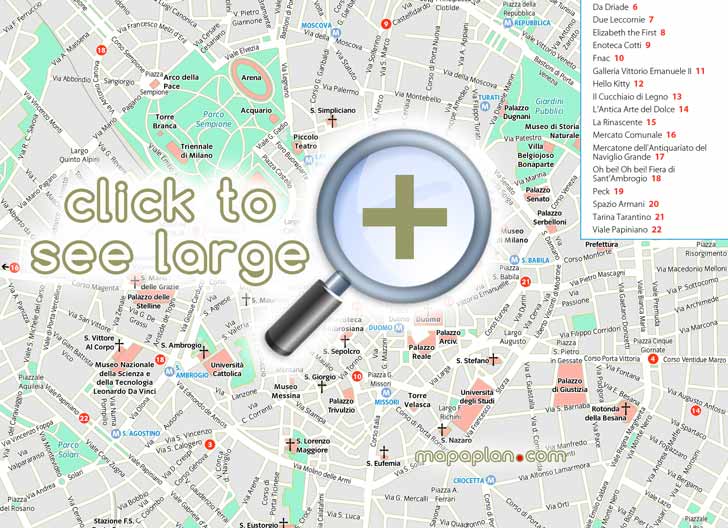
You can view, download or print a full, high resolution (detailed, large) version of this image by clicking on the plan itself
Golden Quadrilateral / Quadrant shopping district map (Quad d'Oro) - Milan top tourist attractions map
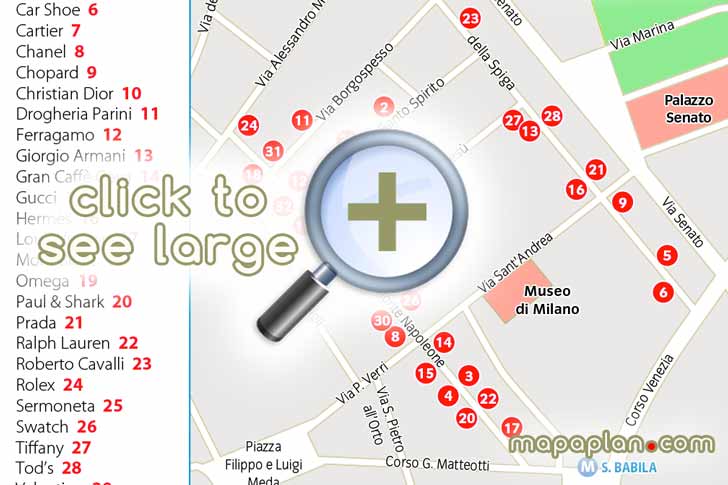
You can view, download or print a full, high resolution (detailed, large) version of this image by clicking on the plan itself
Milan / Milano great family things to do and explore with kids - Fun & interesting ideas where to go with children around central area - Map showing Sempione Park Parco, Sforzesco Castle Castello, Acquario Aquarium - Milan top tourist attractions map
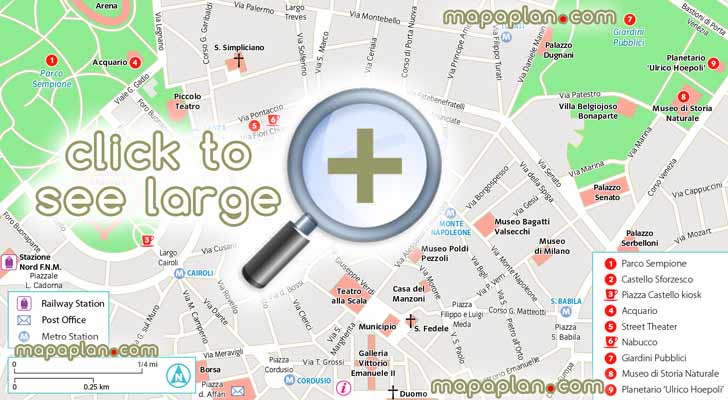
You can view, download or print a full, high resolution (detailed, large) version of this image by clicking on the plan itself
Milan Lakes top attractions & highlights detailed map showing famous sites to explore in 1, 2 & 3 days - Milan top tourist attractions map
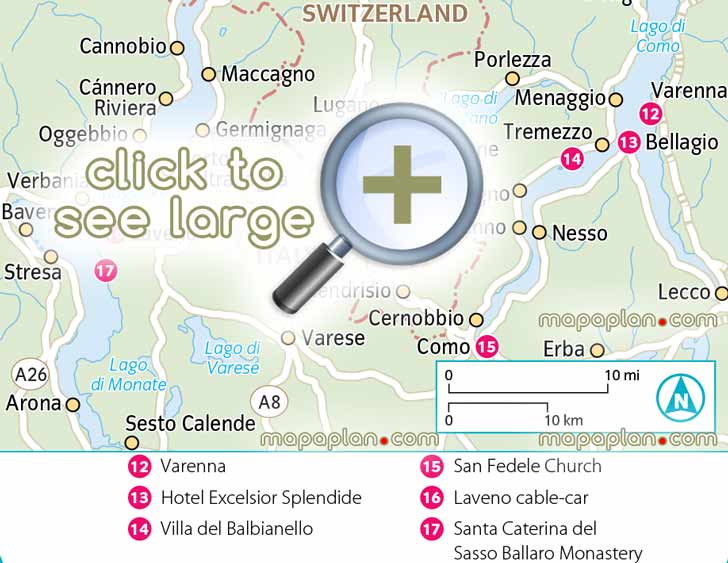
You can view, download or print a full, high resolution (detailed, large) version of this image by clicking on the plan itself
Milan best restaurants & dining map - Central district area outline layout map of best locations to visit - Milan top tourist attractions map
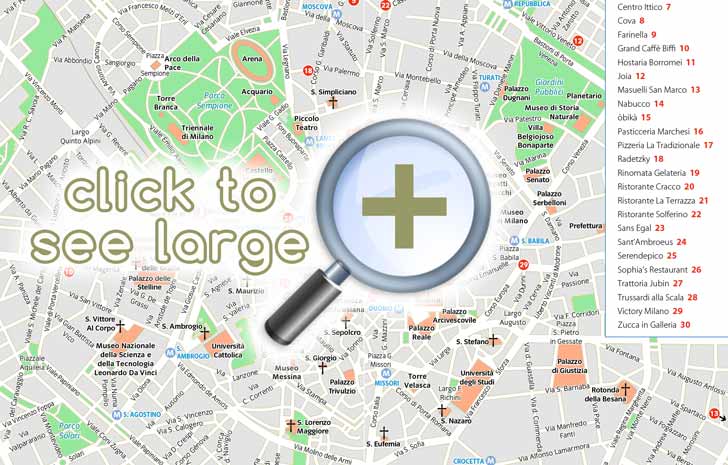
You can view, download or print a full, high resolution (detailed, large) version of this image by clicking on the plan itself
Nightlife map showing best night clubs, bars, entertainment, fun & easy to access places within walking distance - Milan top tourist attractions map
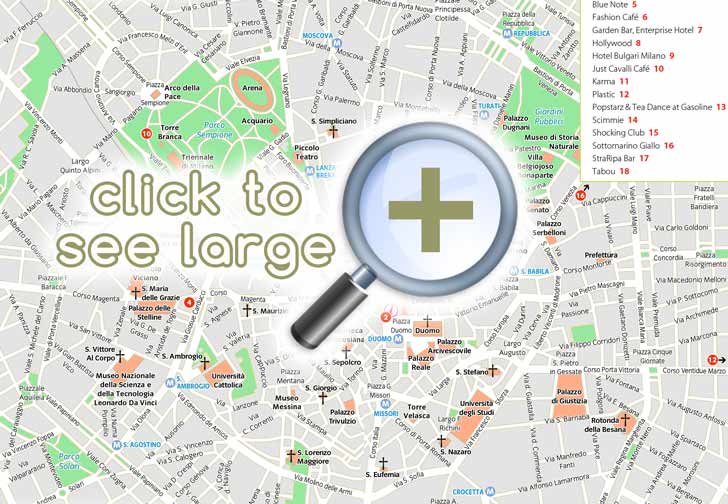
You can view, download or print a full, high resolution (detailed, large) version of this image by clicking on the plan itself
Central Milan hotels & accommodation map with downtown city attractions - Best sights in a week detailed street plan - Milan top tourist attractions map
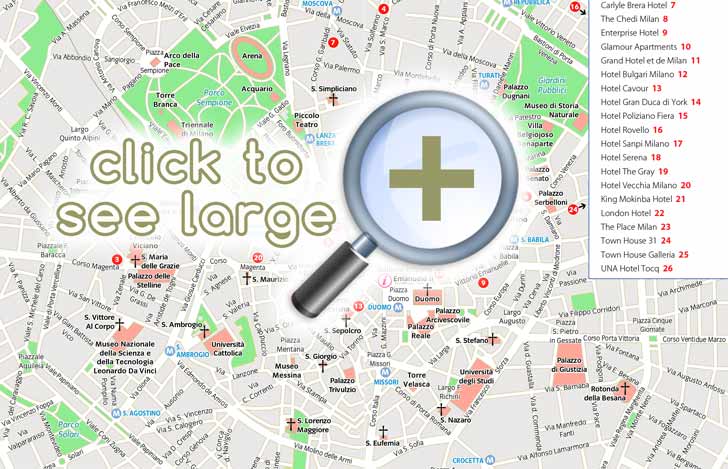
You can view, download or print a full, high resolution (detailed, large) version of this image by clicking on the plan itself
Central Milan attractions printable map showing top 10 sights, metro & train stations, Passante railway stops, tram & bus terminus, tourist information centre, must-see sights, the most iconic locations - Milan top tourist attractions map
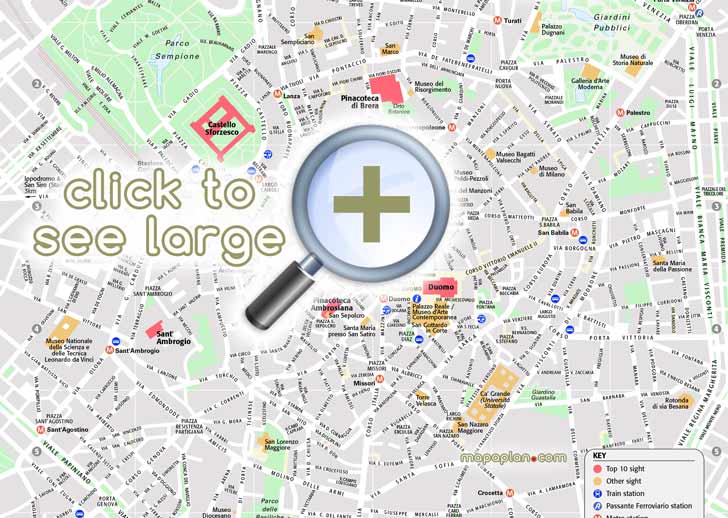
You can view, download or print a full, high resolution (detailed, large) version of this image by clicking on the plan itself
Greater Milan metropolitan region & lakes map showing surrounding area, roads, cities, villages, driving directions to top 10 places of interest, Malpensa & Linate Airport terminals, motorways, highways - Milan top tourist attractions map

You can view, download or print a full, high resolution (detailed, large) version of this image by clicking on the plan itself
Milan region visitors map showing driving guide to airports & urban navigation directions - Greater Milan metro area in Italy - Milan top tourist attractions map

You can view, download or print a full, high resolution (detailed, large) version of this image by clicking on the plan itself
Milan, Italy top attractions interactive map with metro stations & tourist information centre - Milan on the map of Italy - Milan top tourist attractions map

You can view, download or print a full, high resolution (detailed, large) version of this image by clicking on the plan itself
Milan top tourist attractions guide map showing walking tour directions to famous points of interest - Printable detailed travel visitors' itinerary planner with best sights to visit - Milan top tourist attractions map
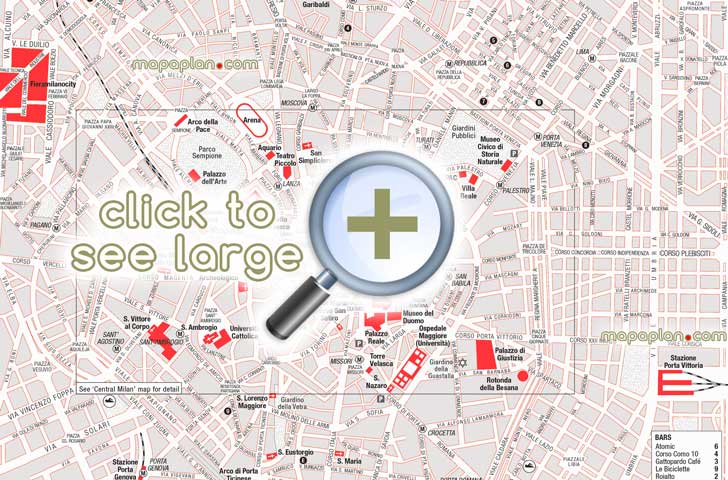
You can view, download or print a full, high resolution (detailed, large) version of this image by clicking on the plan itself
Milano virtual interactive 3d aerial graphical satellite view map showing top tourist attractions to visit - Milan top tourist attractions map
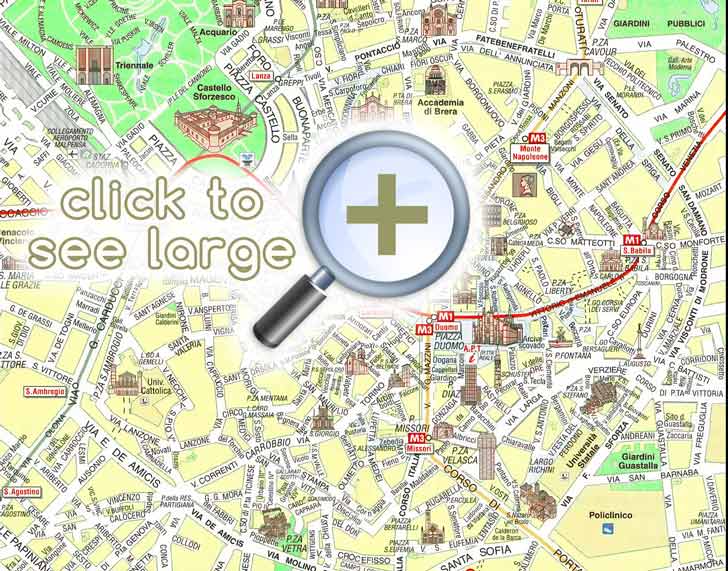
You can view, download or print a full, high resolution (detailed, large) version of this image by clicking on the plan itself
Milan simple outline tourist guide layout map with must-see places, sites to visit, travel guide showing popular places - Milan top tourist attractions map

You can view, download or print a full, high resolution (detailed, large) version of this image by clicking on the plan itself
Map of top 10 attractions in Milan
The typical top ten attractions are listed below. You can find the detailed locations of these places on the maps above.
- Milan Duomo Cathedral - With its ageless marble facade and countless pinnacles and spires piercing the sky, Milan's splendid Gothic cathedral is a veritable outdoor sculpture museum. It is the world's largest Gothic cathedral took more than 400 years to complete, a forest of stone pinnacles, flying buttresses, and more than 3,500 statues. For an unforgettable view, head to the roof.
- Museo del Novecento - Milan's stunning collection of 20th-century art finally has the home it deserves: Italo Rota's remodelled Arengario with its floor-to-ceiling windows overlooking the Duomo.
- Leonardo Da Vinci's Last Supper - Saved from WWII bombs by a bank of sandbags, da Vinci's Il Cenacolo (The Last Supper), on the refectory wall of Santa Maria delle Grazie, is one of the world's iconic images. It is one of the largest and most ingenious works created by the ultimate Renaissance Man. It is in an advanced state of deterioration now, but even the shadow that remains of this great work can teach us volumes about Renaissance ideals.
- Galleria Vittorio Emanuele II - So much more than a shopping arcade, this neoclassical gallery is a soaring iron-and-glass structure known locally as il salotto bueno – the city's fine drawing room. Shaped like a crucifix, it also marks the passeggiata (promenade) route from Piazza del Duomo to Piazza di Marino and the doors of La Scala.
- Castello Sforzesco - Massive castle which is now home to seven diverse museums arranged around two huge central piazzas. The long-time seat and residence of the Dukes of Milan, the Sforza castle is one of the biggest citadels in Europe with walls that once ran 3.5km and 12 sturdy bastions. Now home to collections of tapestries, archaeological artifacts, paintings by Bellini and Mantegna, and sculptures that include Michelangelo's final work, the Rondanini Pieta.
- Pinacoteca Ambrosiana - This cultural study centre founded in the 17th century contains works by Leonardo, Botticelli, Raphael and Caravaggio.
- Duomo Square (Piazza del Duomo) - Milan's centre is conveniently compact. The splendid cathedral sits in a vast piazza thronged with tourists and touts. From here, choose God or Mammon, art or music, or take in all four at the Galleria Vittorio Emanuele II, La Scala opera house and the galleries of Palazzo Reale. Further west, the city's interior design showrooms cluster around Piazza San Babila, amid grand Novecento and Liberty buildings.
- Basilica di Sant'Ambrogio - One of the oldest churches in Milan, it was founded by the city's bishop and patron saint Ambrose in 379. It's filled with mosaics and carvings dating back to the 4th century.
- Pinacoteca di Brera - One of the most important collections in Italy, with masterpieces from the 13th to the 20th century. Particularly strong on Renaissance art. Not to be missed. Founded in the 18th century alongside Italy's most prestigious art academy, this 17th-century palazzo houses one of Italy's finest collections of medieval and Renaissance art; it's inarguably the world's finest collection of northern Italian painting.
- La Scala Opera - One of the most famous opera houses in the world. Take a guided tour of the backstage area, visit the museum, catch a classical performance or, if you're lucky enough to get a ticket, attend the opera.
- Lake Maggiore's Isole Borromee Island - Three verdant islands, one still dominated by a fishing village, the other two clad in the sumptuous villas and ornate gardens of the local ruling Borromeo clan.
- Certosa di Pavia - The pinnacle of the Lombard Renaissance, a vast monastery and church complex in the Po plains with an ornate marble façade, exquisite carved tombs, and some excellent paintings and frescoes.
- Bergamo - The perfect balance of small town charm and sophisticated culture, medieval streets and Renaissance buildings, chic boutiques and hearty home-cooking.
- Mantova - This town is known for its fine Renaissance palaces, its masterpieces by Mantegna and Giulio Romano and its position surrounded on three sides by wide, shallow, swamp-edged lakes. These man-made lakes make the area humid in summer and rather damp and chilly in winter, creating a slight air of melancholy.
- Chruch Chiesa di San Maurizio al Monastero Maggiore - The oldest church in Milan attests to the days when the city was the capital of the Western Roman Empire.
- Chiesa di Santa Maria presso San Satiro - Beautiful church, just south of Piazza del Duomo.
- Stazione Centrale (Central Rail Station) - Majestic, chaotic, noisy, monumental and one of the most unique railway stations in Europe.
What are some interesting facts about Milan?
Getting around Milan - Milan's most famous sights are within walking distance of each other, with Castello Sforzesco, the Duomo, and Via Montenapoleone all 20 minutes apart. However, the public transport system, run by ATM, is a cheap and effective alternative to walking. Travel tickets are valid on all three systems: metros, trams, and buses. Metro stations are well signposted and trains frequent and speedy. Lines 1 (red, with stops for the Duomo and Galleria Vittorio Emanuele II) and 3 (yellow, with a stop at Via Montenapoleone) are the most useful for sightseeing.
Metro - Milan's metro consists of three main underground lines (red MM1, green MM2, yellow MM3) and the blue suburban line the Passante Ferroviario, and runs from 6am to around midnight. An unlimited one-/two-day ticket for bus, tram and metro costs can be bought at metro stations, tobacconists and newspaper stands. Tickets must be validated (time stamped) on buses and trams.
Tram - Milan's trams range from beloved orange, early-20th-century rattling cars to modern lightrail vehicles, crisscrossing and circling the city. Tickets must be prepurchased and validated when boarding. Important tram lines to remember are 1, 2, 3 (all running to the Duomo), 9 (circling the city to Porta Genova), and 29 and 30 (serving the middle ring road and Porta Venezia).
Milan by Streetcar / Tram - For an excellent overview of the city, hop aboard vintage 1920s tram no. 20, distinguished by CIAOMILANO emblazoned on its sides, for a tour with commentary in English and five other languages. The 2-hour tours are hop-on/hop-off for a full day and run daily from Piazza Castello (Metro: Cairoli).
Orientation - Central Milan's spider 's web of streets radiates from the city's geographical and spiritual heart, the Duomo (Cathedral). North of the Duomo is the Quadrilatero d'Oro (Golden Quad), Milan's designer shopping precinct. Northwest is the gentrified, former bohemian quarter of Brera, with narrow cobblestone streets, upmarket antique shops and alfresco cafés. The city's best nightlife is on and around Corso Como, further northwest, beyond which is the edgy Isola design district. Northeast of the Duomo is the Central Rail Station (Stazione Centrale). To the Duomo's south lies the Navigli canal district, while the Castello Sforzesco stands in the Parco Sempione to the west.
City layout - Think of Milan as a series of concentric circles radiating from the Piazza del Duomo at the center. Within the inner circle, once enclosed by the city walls, are many of the churches, museums, and shops that will consume your visiting hours. For a general overview of the lay of the land, obtain one of the serviceable maps, with indices, that the tourist offices provide for free. The city's major neighborhoods encircle the hub, Piazza del Duomo. Heading north from the Piazza del Duomo, walk through the glass-enclosed shopping center (the world's first), the Galleria Vittorio Emanuele II. Emerging from the northern end of the Galleria you'll be just steps away from Piazza della Scala and Milan's famous opera house. A 5-minute walk northeast along Via Manzoni takes you to Via Montenapoleone and the city's high-fashion shopping district, the epicenter of Italian design. A walk of about 10 minutes north of Piazza della Scala along Via Brera brings you into the atmospheric Brera neighborhood.
Tourist information - The APT Milano Information Office, on the corner of via Marconi and Piazza del Duomo, has maps, guidebooks and a free monthly magazine, full of listings and events, called Milano Mese. Also available as a free PDF download from their website.
How can I find specific tourist attractions on the map of Milan?
Our interactive city maps are easy to explore. You can pan, zoom in, and zoom out on the high-resolution map to locate major tourist attractions. Each map highlights key landmarks, making it simple to find the sights you're most interested in, whether it's a famous monument, museum, or other point of interest.
Can I get a visual representation of the area around Milan?
For some cities, we provide a general view of the area surrounding popular attractions. While this image won't show the exact street-level view, it helps you understand the layout of the neighborhood, showing how the landmarks are situated in relation to other points of interest around Milan.
Can I explore maps for both tourist attractions and other points of interest?
Yes! Our platform offers maps covering a range of highlights, from top tourist attractions to other noteworthy areas such as parks, restaurants, and entertainment venues. Whether you're planning a visit to a museum or looking for a nearby park, our detailed maps make it easy to find the best spots in the city.
Related keywords
2023, 2024, 2025, 2025, 2026, 2027, 2028, 2029, map, plan, download, print, printable, free, detailed, aerial, bird's eye, satellite, guide, planner, travel, sightseeing, visit, trip, tour, tourist, what to do, where to go, things to do, must see, top attractions, points of interest, places, sites, sights, buildings, spots, destinations, locations, landmark, museum, in a week, in 3 days, one day, city, route, bus, kids, children, top 10, top ten, popular, famous, interesting, highlights, public transport, rail, hotels, updated, metro, subway, underground, tube, downtown, coach, nightlife, pub, monument, satellite, accommodation, transit, transportation, supermarket, children, metro, subway, underground, tube